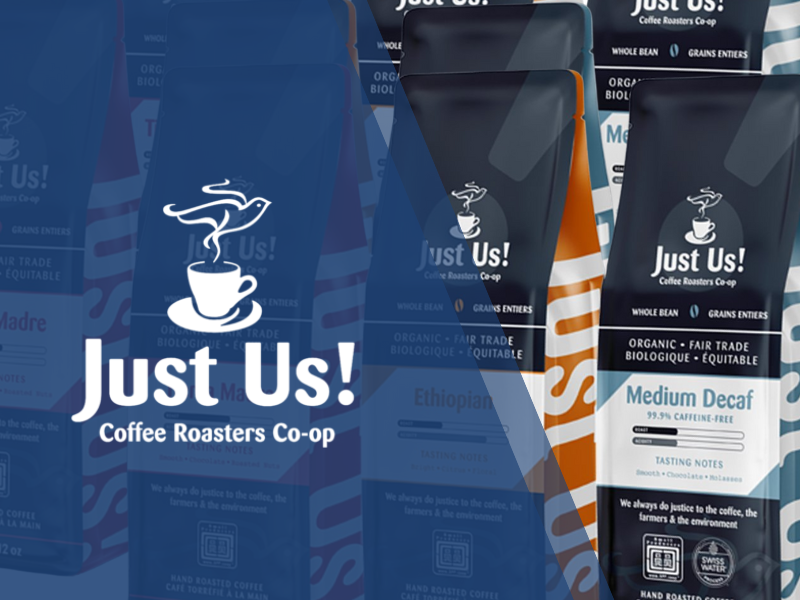Packaging History 101: The evolution of coffee packaging
By Danielle Ohl on April 2, 2019
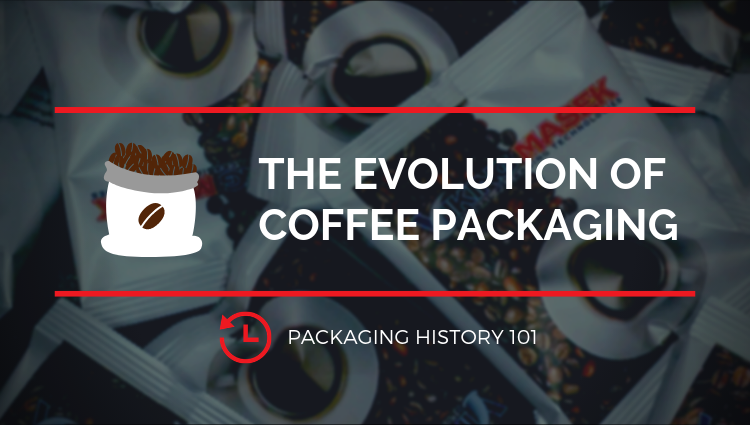
Let's set the stage: It's the year 850, and legend has it that an Ethiopian herdsman named Kaldi observed his goat acting especially chipper after eating red berries from a nearby bush. After consuming the berries himself and experiencing feelings of energy and elation, he ran to the nearest monastery to tell of their amazing effect. The chief monk, thinking Kaldi was possessed, burned the berries in a fire, calling them evil. But later, a rebellious young monk fished the berries from the remains of the fire and mixed them with water for a drink, effectively making himself the first barista. Thus, coffee was born.
And the rest, as they say, is history.
Coffee wouldn't be the mega-industry it is today without packaging. From cans and tins to pods and bottles to flexible bags and pouches, the history of coffee packaging is full of innovations and eureka moments that have shaped its development over time.
So join us for Packaging History 101 and learn about the evolution of coffee packaging! Don't worry, we promise there won't be a test.
Want more packaging history and news? Subscribe for updates or check out another article in the Packaging History 101 series: The evolution of snack packaging.
The 1700s - Coffee packaging firsts
1710 - 1720
In 1710, the French create a way to make coffee by soaking ground coffee in a linen bag in hot water and letting it rest until the desired strength is achieved.
When were coffee bags invented, you ask? In 1720, ground coffee in France was packaged in sacks of greased leather or in bags treated on the outside with beeswax. This is thought to be the original form of the laminated paper bag and was used to conserve flavor.
1790 - 1791
In New York, packages of packed-down roasted coffee were sold in a narrow-mouthed pot or jar of any size. This is considered to be the first crude coffee package in America. It was said coffee would "keep good for twelve months" when packaged in this manner (we're not so sure about that...).
When sold at retail in the U.S., coffee was often carried home in cornucopias of newspapers or any other convenient wrapping.
Early to mid 1800s - The wild wild west
1813
Englishmen Bryan Donkin and John Hall began packaging coffee in cans after establishing the first canning factory in London.
1860 - 1864
In New York, Lewis Osborn created Osborn's Celebrated Prepared Java Coffee, which is considered to be the first ground, prepared, and packaged coffee in history. However, the brand never really took off and was superseded in popularity by Arbuckle's Ariosa (see 1865-1873).
Other packaged coffees of New York in the 1860s included Government coffee distributed by Taber & Place's Rubia Mills. This coffee was packaged in tin foil pound papers.
In 1862, the first paper bag factory to make packages for loose coffee in the United States began its operations. Paper bags were introduced as a more sanitary form of carry package for coffee. This package type quickly became the dominant format for this reason.
 1865
1865
John Arbuckle of New York invented a machine that filled, weighed, sealed, and labeled roasted coffee in individual paper packages "like peanuts".
1873
John Arubuckles's Arbuckle Ariosa became the first mass-produced packaged coffee and was sold nationwide.
Also a marketing whiz, Arbuckle added extras to his coffee packages like coupons redeemable for things like scissors and even wedding rings! Each package also contained a stick of gum to appeal to a younger demographic.
Knowing his coffee was popular among cowboys, Arbuckle began including trading cards with his coffee packages.
Also in 1873, H.C. Lockwood was granted a U.S. patent on a coffee bag made from paper and lined with tin foil.
1878
Chase and Sandborn of Boston, MA became the first to package and ship roasted coffee in sealed cans in America. The seals were created with lead (yes, lead) on large packages and with labels on smaller packages.
1884
The Chicago Liquid Sack Company introduces the first combination paper and tin can for coffee to the U.S.
Late 1800s - Coffee packaging machines arrive on the scene
1880
Henry Smyser of Philadelphia, PA invented a coffee package filling and sealing machine (finally!). This machine made the paper coffee bags, filled them, packed the coffee down, sealed the package, and wrapped the entire pack in glassine paper. Smyser was granted additional patents on coffee packaging machines until 1892, when he began to assign the patents to Arbuckle Brothers.
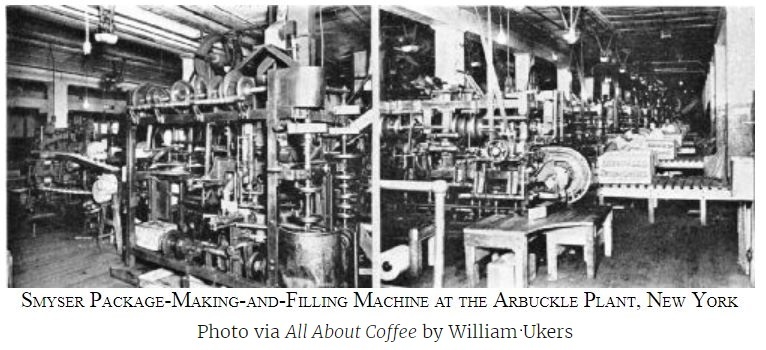
1890 - 1895

In 1890, James A Folger II of the quickly expanding Folgers Company began distributing coffee to grocery stores in large sacks and drums, from which consumers scooped what they needed. Folgers also sold ground coffee in cans for customers who desired more convenience.
In 1891, the New England Automatic Weighing Machine Company in Boston began manufacturing machines that weighed and placed coffee into cartons and other types of packages.
In 1894, the first coffee packing machine from New England Automating Weighing Machine Company was installed at the Chase & Sandborn plant in Boston.
That same year, the Pneumatic Scale Corporation developed a line of coffee packaging machinery.
In 1895, German Adoplph Kraut introduced to America the first grease-proof lined paper bags for coffee. This same year, American Thomas Royal created the first ever multi-layer lined paper bag for coffee.
Early 1900s - The race to enhance freshness
1900 - 1905
In 1900, R.W. Hills of Hills Brothers invented vacuum packing, which removes air from the inside of a container to keep the package contents fresher longer. He was the first to package coffee in vacuum tins, which resulted in much fresher beans. Vacuum packing is still used to this day as a form of Modified Atmosphere Packaging (MAP) in many industries.
In 1901, the American Can Company begins the manufacture of tin cans for coffee in the U.S.
In 1902, German-made automatic coffee packaging and labeling machines were introduced to the United States.
This same year, the first laminated paper bag formed from a roll of paper was produced by the Union Bag & Paper Corp.
 1906
1906
Inventor George Washington (no, not that one) created the first mass-produced instant coffee, which was packaged in tins. Convenient and modern, this coffee was loved by World War 1 soldiers.
Eventually, participation in the World War meant tin was largely unattainable, so coffee packers began to turn to square and oblong paper and fiber containers. Proven practical, economical, and an efficient use of space, this package type grew in popularity.
A push for standardization of coffee packages sizes began.
1916
The Federal Tin Company begins manufacturing tin containers for coffee, to be used in automatic packing machines.
The National Paper Can Company in Milwaukee, WI introduces to the U.S. a new hermetically sealed paper can for coffee.
1922
Packaged retail-sized coffees begin to compete strongly with bulk coffee sales.
1934
Francesco Illy of Italy invented a way to package coffee in pressurized containers. This new coffee packaging solution preserved freshness by filling the coffee cans with inert gas instead of air. This invention enabled Illy to export its coffee to Sweden and Holland during the 1940s, and still remains the standard for preserving coffee's freshness during shipment today.
1953
Folgers introduces Folgers coffee singles, which were instant coffee packaged in a single-serve bag.
1960
An Italian company named Goglio invented the one-way degassing valve, which allows the release of pressurized gases from a package while preventing outside air from entering. These valves are still used widely in the coffee packaging industry today.
Late 1900s - Single-serve pods and cold brews arrive
1969
Japanese businessman Ueshima Tadao saw the success of coffee-flavored milk and decided to flip the ingredient ratio to be mostly coffee with just a little milk and sugar, packaged in a can. Thus, cold-coffee was born. Soon thereafter, illycaffe of Italy packaged pure, straight RTD (ready-to-drink) coffee in a can.
1974
 Ernesto Illy (son of Francesco above) of illycaffe created the first pre-measured espresso pods, making it easy to brew espresso in the home for the first time.
Ernesto Illy (son of Francesco above) of illycaffe created the first pre-measured espresso pods, making it easy to brew espresso in the home for the first time.
1976
Eric Favre of Switzerland, an employee of Nestle, patented the original coffee capsule as part of the Nespresso system.
1992
Green Mountain Coffee Roasters invented the iconic Keurig K-Cup, a single-serve coffee pod made to work with their Keurig home-brew coffee machines.
1996
Chilled, ready-to-drink bottled frappucino was introduced by Starbucks with Pepsico. While it wasn't the first RTD coffee product, it was the first to go mainstream.
The 2000s - Sustainable packaging is hot
2003
Innovia introduced NatureFlex, the world's first renewable and compostable heat sealable cellulose film. This packaging material was used in many industries, including coffee.
Marking the end of an era, Folgers officially phased out its metal coffee cans in favor of plastic canisters. Their reason for the switch was multifold: Plastic containers have the advantage of a built-in handle, they do not need a can opener, and they feature a flavor-saving seal in the lid to preserve freshness.
2015
Coffee Club created PURPOD100, the first 100% compostable single-serve coffee pod.
 2017
2017
Elevate Packaging introduces the first fully compostable coffee bag to market. The entire package is compostable including the films, zippers, and one-way valves.
San Francisco Bay Coffee Co. announced the first "no waste" single-use coffee pod which can be processed at industrial (not backyard) compost facilities.
2018
Tchibo created a new kind of coffee package for its Caffe Crema Vollmundig coffee beans. The bag looks standard at first glance - side gussets and a one-way valve - but upon further inspection, a capped plastic spout is discovered inside the top of one of the side gussets. When the consumer desires to open the bag, they push down and unscrew the cap, cutting a hole in the film. They can then pour out their beans with greater control and reseal the screw the cap, eliminating the need for other reclosure systems.
Convenience store 7-11 debuted self-chilling cans for its new private label Fizzics Sparkling Cold Brew Coffee. This carbonated coffee beverage can be chilled on-demand by twisting the can's bottom cap to lower the beverage's temperature by about 30 degrees in 90 seconds.
Enjoy this post? Subscribe for more!
Did you learn something interesting about the history of coffee packaging from this post? Subscribe to updates from our blog to get articles just like these delivered straight to your inbox!
Subscribe for updates >>
Related Posts
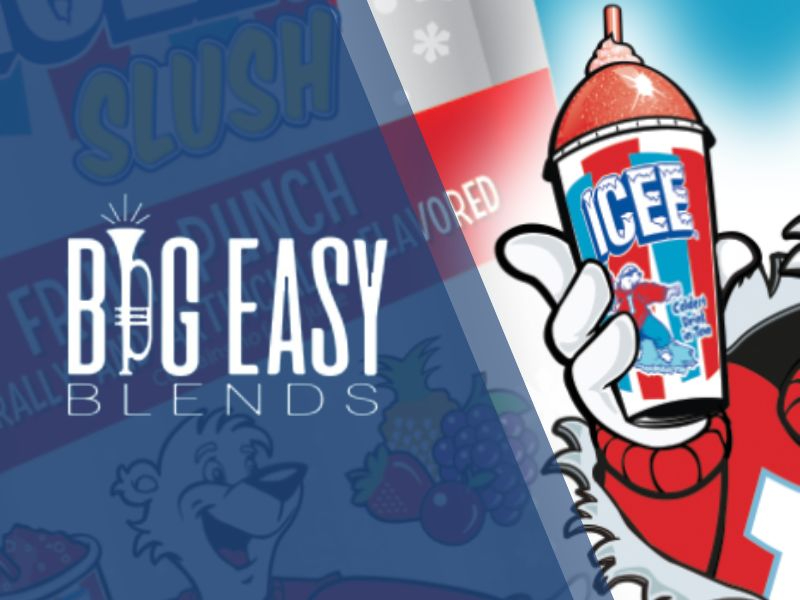
Delivering packaging excellence: How Big Easy Blends improved quality with packaging automation
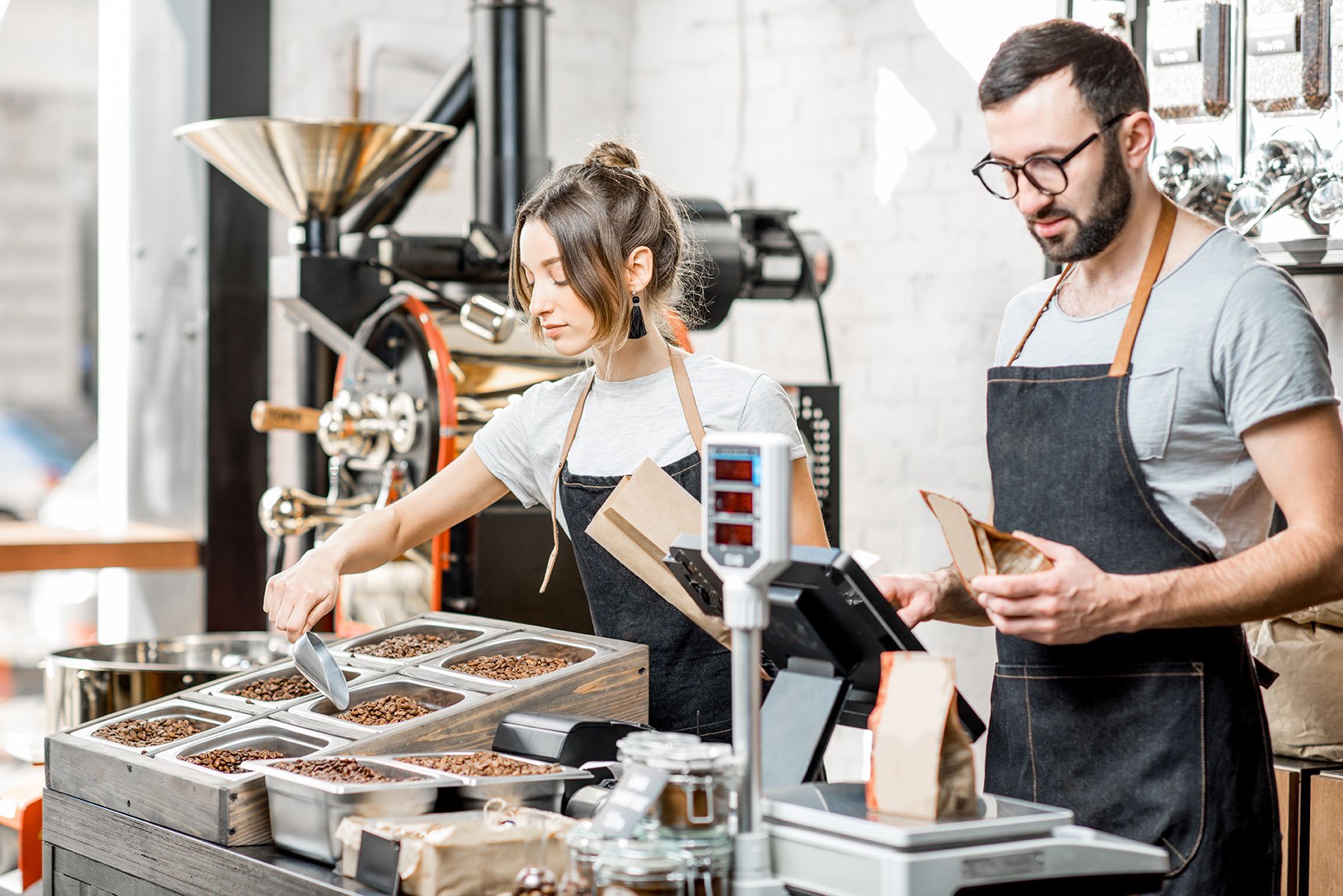
Packaging Your Morning Pick-Me-Up
